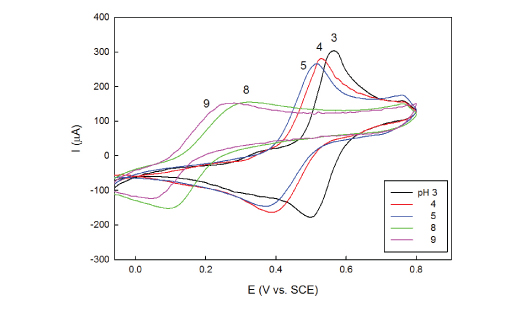Electro-catalytic oxidation of catechol at poly(1-amino-9,10–anthraquinone)-SDS composite film
DOI:
https://doi.org/10.17344/acsi.2016.2260Keywords:
Electro-catalytic oxidation, Coated polymeric film, Catechol, Poly(1-amino-9, 10-anthraquinone) (PAAQ), Sodium dodecyl sulfate (SDS)Abstract
An electro-chemically active composite film containing the environmentally friendly surfactant sodium dodecyl sulfate (SDS) and poly(1-amino-9,10-anthraquinone) (PAAQ) is used as an electron transfer mediator in the electro-chemical oxidation of catechol. Compared with the bare platinum (Pt) electrode, the Pt/PAAQ-SDS modified electrode remarkably lowered the anodic peak potential of catechol, and increased the peak currents. The results obtained indicated that the activation energy for the electro-chemical oxidation of catechol at the polymer film was low (7.05 kJ mol-1). The influence of operational conditions on the response current of the catechol sensor was investigated. Studying the surface morphology of the modified electrode revealed a more porous structure due to the incorporation of the anionic surfactant on the PAAQ film. The modified electrode displayed a linear response range between 0.01 and 8.0 mM of catechol. The lower limit of detection was obtained to be 2.60 mM. The ability of the modified electrode was also examined for the electro-chemical detection of hydroquinone (HQ) with simplicity.
An electro-chemically active composite film containing the environmentally friendly surfactant sodium dodecyl sulfate (SDS) and poly(1-amino-9,10-anthraquinone) (PAAQ) was used as an electron transfer mediator in the electro-chemical oxidation of catechol. Compared with the bare platinum (Pt) electrode, the Pt/PAAQ-SDS modified electrode remarkably lowered the anodic peak potential of catechol, and increased the peak currents. The results obtained indicated that the activation energy for the electro-chemical oxidation of catechol at the polymer film was low (7.05 kJ mol-1). The influence of operational conditions on the response current of the catechol sensor was investigated. Studying the surface morphology of the modified electrode revealed a more porous structure due to the incorporation of the anionic surfactant on the PAAQ film. The modified electrode displayed a linear response range between 0.01 and 8.0 mM of catechol. The lower limit of detection was obtained to be 2.60 * mM. The ability of the modified electrode was also examined for the electro-chemical detection of hydroquinone (HQ) with simplicity.

Downloads
Additional Files
Published
Issue
Section
License
Except where otherwise noted, articles in this journal are published under the Creative Commons Attribution 4.0 International License
